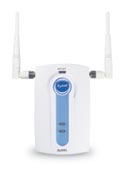ZyXEL
ZyAIR B-3000 and B-420: Intelligent Wireless LAN 802.11b Access
About a year ago, we tried to set-up a home phoneline network for four different
computers on 3 different floors. However, we were plagued with technical problems,
and ended up running CAT 5 wiring across the house. Since then, wireless networking
has lifted off, and we have tested the ZyXEL ZyAIR B-3000 and its companion,
the B-420 for their performance, features and reliability. The B-3000 is a
wireless access point, with a maximal theoretical bit rate of 11 Mbps, capable
of dealing with up to 32 user accounts, and the B-420 is a wireless ethernet
adapter, and as such, can be plugged directly into any RJ-45 port.
| Features |
The
Product |
- High Level of
Network Security Based on WPA*
- Connect Multiple
Sites with Bridge Function
- Connect Multiple
Sites with Bridge Function
- Scalable and
Easy to Deploy
- Seamless Link
Quality Around the Home and Office
|

ZyXEL
|
External
Many of the ZyAIR external stations look alike from the outside. Compactly
shaped, the stations can work stand-alone, or be wall-mounted for better signal
strength. Four multi-coloured LEDs display status: PWR, ETHN, BDG/RPG as well
as the ZyAIR icon.
These convey information
such as presence of a bridge connection, the speed of the ethernet connection,
the status of data (sending/receiving) and much more.
On a more entertaining
note, the “breathing” ZyAIR icon glows a fluorescent blue, signalling
data transfer, makes for a nice lighting effect (while it has no real functional
value, it is a good finishing touch).
Setup
The ZyAIR series runs on the wireless Wi-Fi (802.1b) specifications. Our set-up
was with three desktop computers, one B-3000 access point, and two B-420 adapters.
They were placed on different floors, separated by walls and ceilings by about
30 metres. Hardware set-up was as simple as screwing on antennas and plugging
in the units into ethernet and power.
Also, if power outputs
aren’t conveniently available, the ZyAIR units can run on POE (power
over ethernet) but a separate POE device is required. While the B-420 adapters,
as well as B-300 (not tested) are great for decentralized ad-hoc networks
(peer-to-peer style), the B-3000 is a centrepiece for larger infrastructure
networks (with the access point acting as a hub for the network).
Configuration and security
The B-3000 and B-420 require no drivers to function, as they plug directly
through ethernet. One thing I was pleased with was available configuration
and options: it is simple enough for most home users, yet has powerful features
to suit the tastes of network administrators. The one-of-a-kind menu system
is very useful, and can be accessed through a web-based interface, and even
telnet. The ZyAIR menu requires that the default password be changed upon
start-up, and we find it to be a very good measure for security reasons.
The next measure of privacy
is the WEP encryption, which can be 64-bit, 128-bit, or disabled. MAC filtering
is available on the B-3000, enabling it not only to grant, but also deny access
to the wireless network based on MAC addresses (MAC address is derived from
WLAN network interface card hardware).
Both units are also compatible
with MD5-CHAP (part of the 802.1x standard). MD5-CHAP based authentication
is very simple and easy to set-up, requiring only user names and passwords
to be created. It is fully supported by Windows XP. For tougher security,
however RADIUS (Remote Authentication Dial-In User Service, for B-3000 only)
is recommended since all user IDs and passwords are stored on a remote server
that way, and is less likely to be breached. All access is to the Wi-Fi network
is authenticated, and user accounts are handled directly, so security is kept
tight with both the ZyAIR B-3000 and B-420.
Features
The B-3000 supports a wealth of features which that can also be accessed through
the web-based menu. It can alternate between 3 operating modes: Access Point,
Multiple ESS (Extended Service Set) and Bridge. “Access Point”
is quite self-explanatory. In multiple ESS mode, only stations with the same
ESSID can communicate with one another.
That way, stations can
be grouped together as in a Virtual LAN, and each VLAN can have their own
set of WEP keys. Finally, bridge mode allows the B-3000 to connect two wired
networks. The B-420, on the other hand can operate in Ad Hoc mode, in which
it connects to peer wireless stations, Infrastructure mode, which communicates
through a single access point (the B-3000 in our case), and can also operate
as a bridge for two wired network segments.
Performance
Relative to many other similar wireless networking packages, the ZyAIR terminals
showed very strong signal strength. In our tests, signals between the B-3000
and B-420 held up above 4 Mbps to about a distance of 40 metres. Obviously
these results will certainly be different depending on location and obstructions.
One of the departments
in which the ZyAIR series could improve on is speed; these units certainly
aren’t speed freaks. We achieved peak transfer rates of 5.02 Mbps when
the units were 4 metres apart. At this distance, average transfer rates were
between 4 Mbps and 5 Mbps.
Summation
The ZyAIR units stood up to all our tests, and we were impressed by the quality
of ZyTEL products. As mentioned before, our only complaint was speed, but
then again the 802.1b standard does impose limitations in that regard. Signal
strength and range are outstanding for both units. With MSRP of 149$ for the
B-300 and 125$ for the B-420, they are a steal. The B-3000 is a must-have
for SOHOs and small businesses with secure wireless networking needs, and
the B-420, a great starting point, or expansion for smaller wireless ad hoc
or infrastructure networks.
Amit
Rahman 
04.02.12